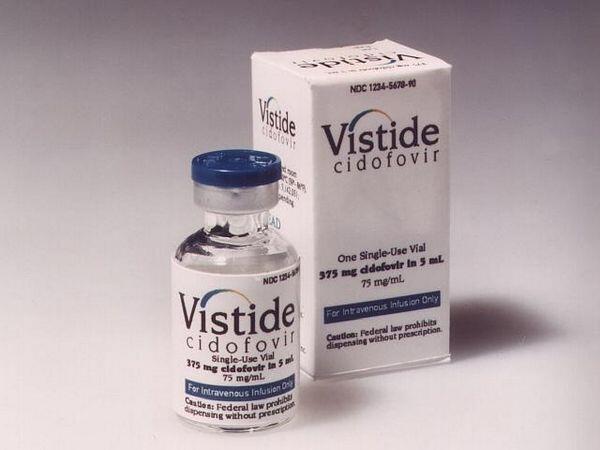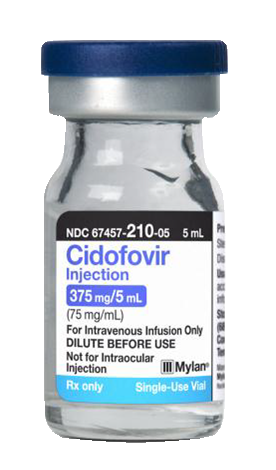Drug Approvals
INNs in other languages (French, Latin, and Spanish): Synonyms: Cidofovir; Cidofovirum; GS-0504; GS-504; HPMPC; Sidofoviiri BAN: Cidofovir USAN: Cidofovir INN: Cidofovir [rINN (en)] INN: Cidofovir [rINN (es)] INN: Cidofovir [rINN (fr)] INN: Cidofovirum [rINN (la)] INN: Цидофовир [rINN (ru)] Chemical name: {[(S)-2-(4-Amino-2-oxo-1(2H)-pyrimidinyl)-1-(hydroxymethyl)ethoxy]methyl}phosphonic acid; 1-[(S)-3-Hydroxy-2-(phosphonomethoxy)propyl]-cytosine Molecular formula: C8H14N3O6P =279.2 CAS: 113852-37-2 (anhydrous cidofovir); 149394-66-1 (cidofovir dihydrate) ATC code: J05AB12 Read code: y0ATd
Adverse Effects
The most serious dose-limiting adverse effect of cidofovir is nephrotoxicity the incidence and severity of which can be reduced by use with probenecid and by ensuring adequate hydration. There have been instances of acute renal failure after only 1 or 2 doses, and some fatalities. Low plasma-bicarbonate concentrations and metabolic acidosis, sometimes associated with proximal tubule injury and renal wasting syndrome (including Fanconi’s syndrome) or with liver dysfunction and pancreatitis, have been reported. Reversible neutropenia has also occurred. Other adverse effects include nausea and vomiting, fever, asthenia, skin rash, dyspnoea, alopecia, and ocular hypotony (decreased intra-ocular pressure). Iritis or uveitis has been reported. Cidofovir is carcinogenic and embryotoxic in animals and may have the potential to cause male infertility (see Precautions, below).

Effects on the eyes
Ocular adverse effects associated with intravenous use of cidofovir include iritis, uveitis, and ocular hypotony. While development of ocular hypotony is considered to warrant withdrawal of cidofovir, uveitis or iritis alone may respond to topical corticosteroids and cycloplegics thus allowing antiviral therapy to be continued; cidofovir must be stopped if there is no response or worsening of symptoms.
Effects on the kidneys
Dose-related nephrotoxicity is the most severe adverse effect of cidofovir and marked proteinuria has been reported in up to 50% of patients. There have been instances of acute renal failure after only 1 or 2 doses, and some fatalities. Fanconi’s syndrome associated with renal tubular damage has been reported in 2% of patients and, in one such patient, occurred on the third injection of cidofovir and resulted in irreversible renal impairment. Reversible renal impairment with persisting Fanconi syndrome was reported in another. A case of nephrogenic diabetes insipidus without premonitory laboratory abnormalities has also been reported in a patient given cidofovir.
Precautions
Cidofovir is contra-indicated in patients with renal impairment. Renal function should be measured before each dose. In the UK it is recommended that treatment should be interrupted or stopped if renal function deteriorates, but in the USA reduction of the dosage is permitted for increases in serum creatinine up to 300 to 400 inicrograms/dL above baseline. Patients should receive oral probenecid and intravenous hydration with each dose of cidofovir. Neutrophil counts should also be monitored and regular ophthalmological follow-up is recommended. Patients with diabetes mellitus are at increased risk of ocular hypotony. Cidofovir is carcinogenic and embryotoxic in animals. Cidofovir should not be given during pregnancy and both sexes should use effective methods of contraception during treatment; in addition, effective contraception should be used, for 1 month by women and for 3 months by men, after the end of treatment. There is also a possibility that cidofovir may cause male infertility. Cidofovir should be given intravenously only; direct intra-ocular injection has been associated with significant ocular hypotony and visual impairment and is contra-indicated.
Interactions
Additive nephrotoxicity may occur if cidofovir is used with other nephrotoxic drugs such as aminoglycosides, amphotericin B, foscarnet, intravenous pentamidine, vancomycin, or NSAIDs. Potentially nephrotoxic drugs should be stopped at least 7 days before starting cidofovir. Probenecid, which is given with cidofovir, may alter the clearance of other drugs (see Interactions under Probenecid). Patients with CMV retinitis are at increased risk of adverse inflammatory effects if cidofovir is given within 2 to 4 weeks of intravitreal fomivirsen.
Antiviral Action
Cidofovir undergoes intracellular phosphorylation by cellular kinases to the antiviral metabolite, cidofovir diphosphate, which acts as a competitive inhibitor of viral DNA polymerase. It is active against a range of herpesviruses including CMV, and, since its activity is not reliant on viral enzymes, may retain activity against some aciclovir- and foscarnet-resistant viruses. Cross-resistance with ganciclovir is common.
Pharmacokinetics
After intravenous doses of cidofovir, serum concentrations decline with a reported terminal half-life of about 2.2 hours (the intracellular half-life of the active diphosphate may be up to 65 hours). Cidofovir is eliminated mainly by renal excretion, both by glomerular filtration and tubular secretion. About 80 to 100% of a dose is recovered unchanged from the urine within 24 hours. Use with probenecid may reduce the excretion of cidofovir to some extent by blocking tubular secretion, although 70 to 85% has still been reported to be excreted unchanged in the urine within 24 hours.
Uses and Administration
Cidofovir is a nucleoside analogue that is active against herpesviruses. It is used in the treatment of CMV retinitis in patients with AIDS, and is being investigated for ocular herpes simplex and other viral infections. In the treatment of CMV retinitis, cidofovir is given in a dose of 5 mg/kg by intravenous infusion over 1 hour once a week for 2 consecutive weeks, then once every 2 weeks for maintenance. Probenecid 2 g is given orally 3 hours before each dose of cidofovir and further 1 g doses of probenecid at 2 and 8 hours after completion of the infusion. To ensure adequate hydration, 1 litre of sodium chloride 0.9% is given by intravenous infusion over 1 to 2 hours immediately before each infusion of cidofovir; if the additional fluid load can be tolerated, a further 1 litre of sodium chloride 0.9% may be infused over 1 to 3 hours, starting at the same time as (or immediately after) the cidofovir infusion. For details of modified use of cidofovir in patients with renal impairment, see below. Cidofovir has also been given experimentally by intravitreal injection but the commercially available formulation is unsuitable for use by this route and licensed product information advises against it (see Precautions, above). An orally active prodrug of cidofovir known as cyclic-HPMPC (GS-930) is under investigation. Cidofovir has also been investigated for topical use.
Administration in renal impairment
Cidofovir is contra-indicated in patients with pre-existing renal impairment (serum creatinine more than 1.5 mg/dL) and should be interrupted or stopped if serum creatinine increases by more than 500 micrograms/dL during therapy; in the USA, a reduction in the maintenance dose from 5 to 3 mg/kg is permitted for increases of serum creatinine of up to 300 to 400 micrograms/dL above baseline.
Viral infections
In addition to its use in CMV retinitis, cidofovir has been studied in herpes simplex infections, papillomavirus infections, molluscum contagiosum, and progressive multifocal leukoencephalopathy.
Proprietary Preparations
Australia: Vistide; Austria: Vistide; Belgium: Vistide; Czech Republic: Vistide;
France: Vistide; Germany: Vistide;
Greece: Vistide; Italy: Vistide; Portugal: Vistide; Spain: Vistide; Switzerland: Vistide; United Kingdom: Vistide; USA: Vistide


